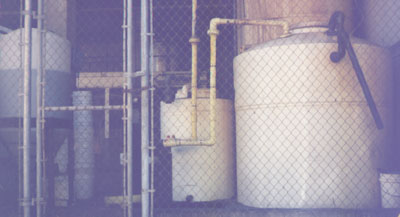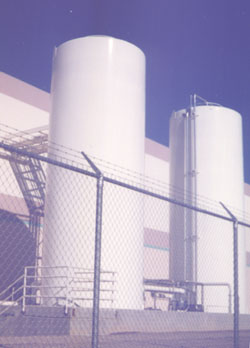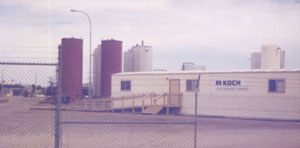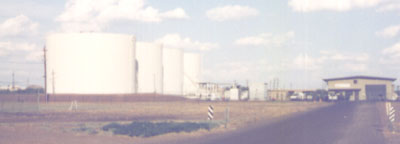 Want to guess which hazardous chemical is in which container? The BOLDER
Project solves all the guesswork. The contents of each tank can be
available at the scene of an incident because far more accurate and detailed
information is available using the BOLDER Project.
Want to guess which hazardous chemical is in which container? The BOLDER
Project solves all the guesswork. The contents of each tank can be
available at the scene of an incident because far more accurate and detailed
information is available using the BOLDER Project.
 It is impossible to tell just by looking that these two enormous tanks
contain Sugar water. The facility reports for Ammonia, Chlorine, Nitric acid
and Sulfuric acid on its Tier Two Reports, but a label on these tanks would
be very helpful to emergency responders so as not to waste time on tanks
that do not pose a threat.. Alert citizens helped this facility come into
compliance and file Tier Two Reports for the Ammonia, Chlorine, Nitric acid
and Sulfuric acid on-site.
It is impossible to tell just by looking that these two enormous tanks
contain Sugar water. The facility reports for Ammonia, Chlorine, Nitric acid
and Sulfuric acid on its Tier Two Reports, but a label on these tanks would
be very helpful to emergency responders so as not to waste time on tanks
that do not pose a threat.. Alert citizens helped this facility come into
compliance and file Tier Two Reports for the Ammonia, Chlorine, Nitric acid
and Sulfuric acid on-site.
 This facility has several tanks of asphalt and asphalt emulsions, which are
heated and can certainly burn. Would you want to be a firefighter trying to
respond to an incident here without Tier Two information? What chemical or
mixture is in each of these tanks? Which ones are heated? Which ones need to
be cooled with water first?
This facility has several tanks of asphalt and asphalt emulsions, which are
heated and can certainly burn. Would you want to be a firefighter trying to
respond to an incident here without Tier Two information? What chemical or
mixture is in each of these tanks? Which ones are heated? Which ones need to
be cooled with water first?

There are different types of jet fuels in these tanks. The facility is
adjacent to a very busy airport. Jet fuel fires are difficult to control
and fight even when there are emergency planning and preparations in advance
and emergency equipment on-site. A jet fuel fire at Denver's Stapleton
airport was uncontrollable and had to just burn itself out. Alert citizens
helped this facility come into compliance and file Tier Two Reports for the
millions of gallons of fuels on-site. Years later, the pipeline that brought
the jet fuels to the facility ruptured, and jet fuel was found on the public
road near these tanks. Thanks to Tier Two reports, the spill did not cause a
fire.
Photo#11

Photo #12
 These tanks are part of an enormous petroleum tank farm, which present
special hazards due to the large amounts of fuels on-site. Not all of these
tanks were full, either. Up-to-date Tier Two reporting can help firefighters
discern this information in the event of a disaster, but the real-time
information provided by the BOLDER Project is actually what is needed. If a
tank has been emptied for repairs or other maintenance, the BOLDER Project
allows that updated data to be transmitted to the fire department so
firefighters will know to not put water on an empty tank. Alert citizens
helped this facility come into compliance and file Tier Two Reports for the
millions of gallons of fuels on-site. Because the fuels arrived by pipeline
and were stored prior to being sold and transported off-site in bulk tanker
trucks, the facility thought mistakenly that the transportation exemption
applied.
These tanks are part of an enormous petroleum tank farm, which present
special hazards due to the large amounts of fuels on-site. Not all of these
tanks were full, either. Up-to-date Tier Two reporting can help firefighters
discern this information in the event of a disaster, but the real-time
information provided by the BOLDER Project is actually what is needed. If a
tank has been emptied for repairs or other maintenance, the BOLDER Project
allows that updated data to be transmitted to the fire department so
firefighters will know to not put water on an empty tank. Alert citizens
helped this facility come into compliance and file Tier Two Reports for the
millions of gallons of fuels on-site. Because the fuels arrived by pipeline
and were stored prior to being sold and transported off-site in bulk tanker
trucks, the facility thought mistakenly that the transportation exemption
applied.
One of the many incidents that helped get EPCRA passed was the Roseville, Minnesota incident involving just this type of fire. In Roseville, the large gasoline storage tanks leaked and a fire started that damaged homes and killed some people. Because EPCRA did not exist, firefighters and police had no idea what chemicals were stored there, their quantities, or even that they were there in the first place, hindering response. The Roseville fire burned for days.